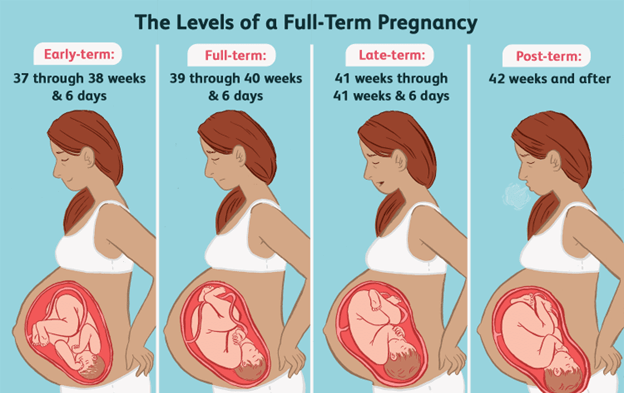Post-term birth
- Definition: Birth after 42 weeks of gestation
- Causes: Unknown; possible factors include inaccurate estimation of due date, genetic predisposition, placental insufficiency
- Signs and symptoms: Wasted appearance due to loss of subcutaneous fat; peeling, cracked, leathery skin; long hair and nails; meconium staining on nails or umbilical cord; macrosomia or intrauterine growth restriction; oligohydramnios (low amniotic fluid volume); fetal distress; hypoxemia; hypoglycemia; polycythemia; hyperbilirubinemia
- Assessment: Determine gestational age using ultrasound or last menstrual period date; measure weight, length, head circumference; monitor vital signs and oxygen saturation; assess for signs of distress or injury; perform heel stick blood glucose test using a glucometer; perform laboratory tests as ordered (e.g., blood gas analysis, hematocrit); perform diagnostic tests as ordered (e.g., chest X-ray)
- Nursing interventions: Deliver the baby vaginally with induction or augmentation of labor if needed or by cesarean section if indicated; provide oxygen therapy if needed; maintain thermoregulation by keeping the baby warm and dry; feed the baby as soon as possible after birth; monitor blood glucose levels frequently until stable; administer IV dextrose solution if needed; monitor hematocrit levels and perform partial exchange transfusion if needed; monitor bilirubin levels and provide phototherapy if needed; educate parents on signs of hypoglycemia and how to feed the baby

Nursing Test Bank
Quiz #1: RN Exams Pharmacology Exams
Quiz #2: RN Exams Medical-Surgical Exams
Quiz #3: RN Exams Fundamentals Exams
Quiz #4: RN Exams Maternal-Newborn Exams
Quiz #5: RN Exams Anatomy and Physiology Exams
Quiz #6: RN Exams Obstetrics and Pediatrics Exams
Quiz #7: RN Exams Fluid and Electrolytes Exams
Quiz #8: RN Exams Community Health Exams
Quiz #9: RN Exams Promoting Health across the lifespan Exams
Quiz #10: RN Exams Multidimensional care Exams
Naxlex Comprehensive Predictor Exams
Quiz #1: Naxlex RN Comprehensive online practice 2019 B with NGN
Quiz #2: Naxlex RN Comprehensive Predictor 2023
Quiz #3: Naxlex RN Comprehensive Predictor 2023 Exit Exam A
Quiz #4: Naxlex HESI Exit LPN Exam
Quiz #5: Naxlex PN Comprehensive Predictor PN 2020
Quiz #6: Naxlex VATI PN Comprehensive Predictor 2020
Quiz #8: Naxlex PN Comprehensive Predictor 2023 - Exam 1
Quiz #10: Naxlex HESI PN Exit exam
Quiz #11: Naxlex HESI PN EXIT Exam 2
Questions on Post-term birth
Correct Answer is C
Explanation
<p>An infection may cause fetal distress, but it is not the direct cause of meconium staining.Meconium staining may be a sign of infection in the newborn.</p>
Correct Answer is A
Explanation
Premature rupture of membranes (PROM) is not directly caused by oligohydramnios.
PROM is when the amniotic sac breaks before the onset of labor, causing leakage of fluid and increased risk of infection.
This can be caused by infection, cervical incompetence, or mechanical factors.
Correct Answer is A
Explanation
Anemia is not related to insulin or glucose levels.
Anemia is a condition where there are not enough red blood cells or hemoglobin in the blood, which can cause decreased oxygen delivery to the tissues.
This can happen in newborns due to blood loss, hemolysis, or decreased production of red blood cells.
Blood tests are not needed every 12 hours, but only when indicated by the bilirubin level or risk factors.
A hematocrit value of 65% indicates polycythemia, which is an abnormally high number of red blood cells.
Polycythemia can occur in post-term newborns who have hypoxemia, which is a low level of oxygen in the blood. Hypoxemia stimulates the production of erythropoietin, a hormone that increases r
Search Here
Related Topics
More on Nursing
Free Nursing Study Materials
Access to all study guides and practice questions for nursing for free.
- Free Nursing Study Trials
- Free Nursing Video tutorials
- Free Nursing Practice Tests
- Free Exam and Study Modes
- Free Nursing Revision Quizlets
